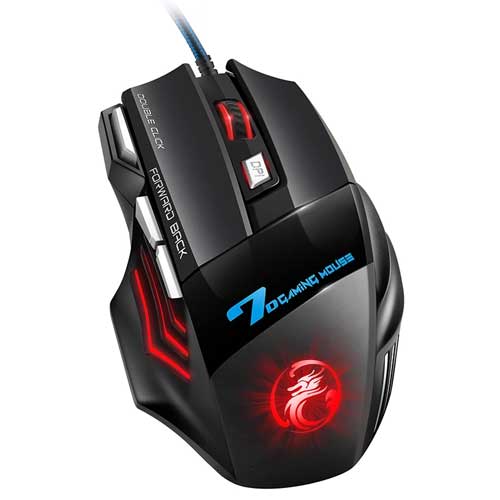Welcome to a guide and list of the different types of computer mouse. A computer mouse is a gadget that we commonly see these days, but not many people will even think twice about it. A mouse is a mouse, right? What is so interesting about it? You will be surprised.
There are actually quite a number of different “species” of computer mice – Wired, wireless, optical, mechanical, laser, trackball, and more. Just what are the differences, how do they work, and which is the “best mouse” to use? Read on!
TABLE OF CONTENTS
 Types of Mouse Types of Mouse |
 Useful Bits Useful Bits |
 The End The End |
TYPES OF COMPUTER MOUSE

Let us now walk through the various types of computer mice in this section.
1) WIRELESS MOUSE

Otherwise known as a cordless mouse, these refer to every mouse that does not have a piece of cable sticking out; Instead of using the “traditional” cables, wireless mice use radio frequency (RF) to communicate with computer devices. There are 2 parts to the equation:
- The mouse itself acts as the transmitter, giving out wireless signals as you move and click.
- The computer will receive those wireless signals and act accordingly.
As to the “wireless signals” part, please take note that it is not universal – Some wireless mouse uses the common Bluetooth standard, some uses a 2.4 GHz wireless standard, and a few others have their own proprietary wireless USB dongle.
The good: Freedom! Carry the mouse all around, with no messy wires to deal with.
The bad: Requires batteries. Even though wireless mouse uses very little power and should last pretty long, but they still need fresh batteries once in a while… Running out of batteries in the middle of a game or presentation is always a bad situation.
2) WIRED MOUSE

As you might have guessed it, wired mice refer to every mouse that has an attached cable and requires to be plugged into a computer device. For those who are thinking that wired mice are “low tech”, “outdated”, and “inferior” – They are not, and are essentially the same as their wireless counterparts… Less wireless circuits and no batteries are required.
The good: Will never run out of battery… Because there is none.
The bad: You will have to deal with a piece of cable.
3) MECHANICAL MOUSE

The mechanical mouse is what we use in the good old days and is one of the most traditional mice in the history of computers. It is otherwise known as a ball mouse because it uses a rubber ball to detect motion – That ball spins along as you move the mouse, and sensors will pick up on which direction you moved.
The good: For collection… A mechanical mouse is kind of cool, but sadly, they have gone extinct and are no longer manufactured.
The bad: Mechanically driven, the wheels and sensors will wear out over time.
4) OPTICAL MOUSE

This is the common Joe mouse that you see everywhere these days. But instead of using a rubber ball and mechanical sensors, an optical mouse uses an LED and detects movement by sensing changes in the reflected light.
The good: No dirty rubber balls to clean. But please take note that even though the optical mouse uses light to detect motion, it is not totally “mechanical free” – The buttons and scroll wheel are still mechanical in nature and will wear out over time… It’s just that optical mice will last longer with fewer mechanical parts.
The bad: Optical mice will not work properly on surfaces that do not reflect light, such as a piece of clear glass or plastic.
5) LASER MOUSE

The laser mouse is also a kind of optical mouse, and the working principles are the same – To sense the movement by reflecting light. But just as the name implies, a laser mouse uses a laser beam instead of an LED. This basically allows the mouse to be used on glass and plastic surfaces due to the different properties of light but suffers from some inaccuracy.
The good: Works on glass and plastic surfaces.
The bad: Not as accurate an optical mouse.
6) GAMING MOUSE

While a typical mouse usually only has 3 buttons, a gaming mouse is characterized by having many buttons and touting itself to be accurate. These extra buttons are often programmable to do various things… Mostly for the purpose of gaming.
The good: Programmable buttons, very useful even for non-gaming purposes. For example, they can be used as forward and backward buttons for web browsing or video playback.
The bad: Big and bulky, not for those who are looking for something more delicate.
7) TRACKBALL MOUSE

A trackball mouse is something like an upside-down ball mouse. Instead of moving the mouse around, it detects motion by spinning the ball using the thumb or palm of the hand. Even though it works similarly to the ball mouse, the design of the trackball mouse is totally different.
The ball itself is typically made of dense glass or plastic, it is smooth and does not attract dirt as sticky rubber does. Some trackball mouse is also made to be held in one hand and acts more like a remote control than a mouse.
The good: The gadget stays stationary on the desk or is handheld. The cord will never get tangled… Unless you intentionally want to.
The bad: Just like a ball mouse, it uses mechanical sensors that are susceptible to mechanical failures.
8) STYLUS MOUSE

This is a “mutated mouse” that is a cross between a pen and a mouse. Favored by digital artists, the stylus mouse is about the size of a very fat brush, typically used for freehand drawing with computers. Yep, some of the higher-end stylus mice are even sensitive to touch pressure for emulating actual brush strokes on paper.
The good: If you like to draw, this is your cup of tea.
The bad: Not your conventional mouse, the better stylus mice can be expensive.
9) PRESENTATION MOUSE

Once upon a time, we have to carry a laser pointer, a mouse, and an extra person for presentations. We often have to shout “next slide” for that someone to click on the mouse. Some smart monkeys thought it will be a good idea to combine a mouse and laser pointer together, and it is.
The good: Laser pointer and mouse, 2-in-1. Some can function as a smart TV remote as well.
The bad: Not your conventional mouse. Depending on the design, some presentation mouse doesn’t have a trackball or ways to move the cursor.
10) VERTICAL MOUSE

Yes, this is a mouse that stands upright, and you sort of “grab” it… Probably one of the “weirder” mice on the entire list, but this design has so-called “better ergonomics”.
The good: Supposed to be ergonomic, and more comfortable to use for long hours.
The bad: Not symmetrical, have to buy specifically for left or right-handed.
USEFUL BITS & LINKS

That’s all for this guide, and here is a small section on some extras and links that may be useful to you.
WHICH IS THE FAIREST OF THEM ALL?
Well, everyone has a different need – Some people just want to do some casual work, some people like to paint, and some are gamers. Every mouse is designed for a different purpose, and there really isn’t “one mouse to rule them all”. So whichever mouse works for you is the best mouse.
LINKS & REFERENCES
- The Different Types of Computer Mice – Dummies
- Different Types of Computer Mouses – Techwalla
THE END

Thank you for reading, and we have come to the end of this guide. I hope that this has helped you to better understand the computer mice, and if you have anything to share with this guide, please feel free to comment below. Good luck and happy computing. May the cyber force be with you.

Thanks a lots for these good iiformation and highlighted points on computing mouse, I appreciate and God bless you, we will like more and others as well.
Wow this is just amazing
have not seen some of these mice before
yeah i could’nt agree more
You’re missing one type, the track point. It’s my favorite when it’s found even as rare as they are.
Track points are more of a “pointer device” than a mouse to me. If I do consider track points to be mice, then trackpads and joysticks will need to be included in the list too…
very nice
Very impressive and helping. Looking forward to the next article about modern technology